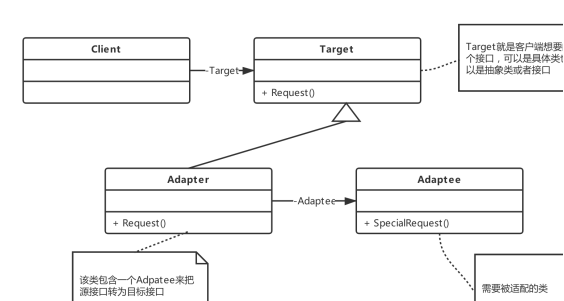php设计模式-适配器模式
适配器模式其实也是一种为了解耦的设计模式,为了让客户端的调用变得更简单统一,将源接口转换为目标接口的过程封装到特定的过程中,这个过程就叫适配。
逻辑图如下:

将特定的需要适配的类作为装饰器的一个成员变量进行注入,然后再暴露同一个调用接口。
具体代码如下:
<?php /** * Created by PhpStorm. * User: tonny * Date: 2019/7/15 * Time: 20:44 */ interface Target { public function charge(); } class Adapter implements Target { protected $adaptee = null; public function __construct($adaptee) { $this->adaptee = $adaptee; } public function charge() { $className = get_class($this->adaptee); if ($className == 'StreetEl') { $this->adaptee->shareCharge(); } else if ($className == 'Battery') { $this->adaptee->selfCharge(); } } } class StreetEl { public function shareCharge() { echo "share way to charge it!\r\n"; } } class Battery { public function selfCharge() { echo "self charging by battrey!\r\n"; } } $streeEl = new StreetEl(); $battery = new Battery(); $adapter = new Adapter($streeEl); $adapter->charge();
这样代码的可扩展性和复用性能够很大的提高,也符合“开闭原则”。当然它也有坏处,可能会造成调用复杂,比如调用的是A,实际是调用的C。
当然还有更符合php特色的写法,将需要适配的类的初始化也放到Adapter的构造函数里面,利用字符串变量来动态new对象。在这里只为了阐述通用型的适配器模式,就不展开说了。






【推荐】国内首个AI IDE,深度理解中文开发场景,立即下载体验Trae
【推荐】编程新体验,更懂你的AI,立即体验豆包MarsCode编程助手
【推荐】抖音旗下AI助手豆包,你的智能百科全书,全免费不限次数
【推荐】轻量又高性能的 SSH 工具 IShell:AI 加持,快人一步
· 基于Microsoft.Extensions.AI核心库实现RAG应用
· Linux系列:如何用heaptrack跟踪.NET程序的非托管内存泄露
· 开发者必知的日志记录最佳实践
· SQL Server 2025 AI相关能力初探
· Linux系列:如何用 C#调用 C方法造成内存泄露
· 无需6万激活码!GitHub神秘组织3小时极速复刻Manus,手把手教你使用OpenManus搭建本
· Manus爆火,是硬核还是营销?
· 终于写完轮子一部分:tcp代理 了,记录一下
· 别再用vector<bool>了!Google高级工程师:这可能是STL最大的设计失误
· 单元测试从入门到精通